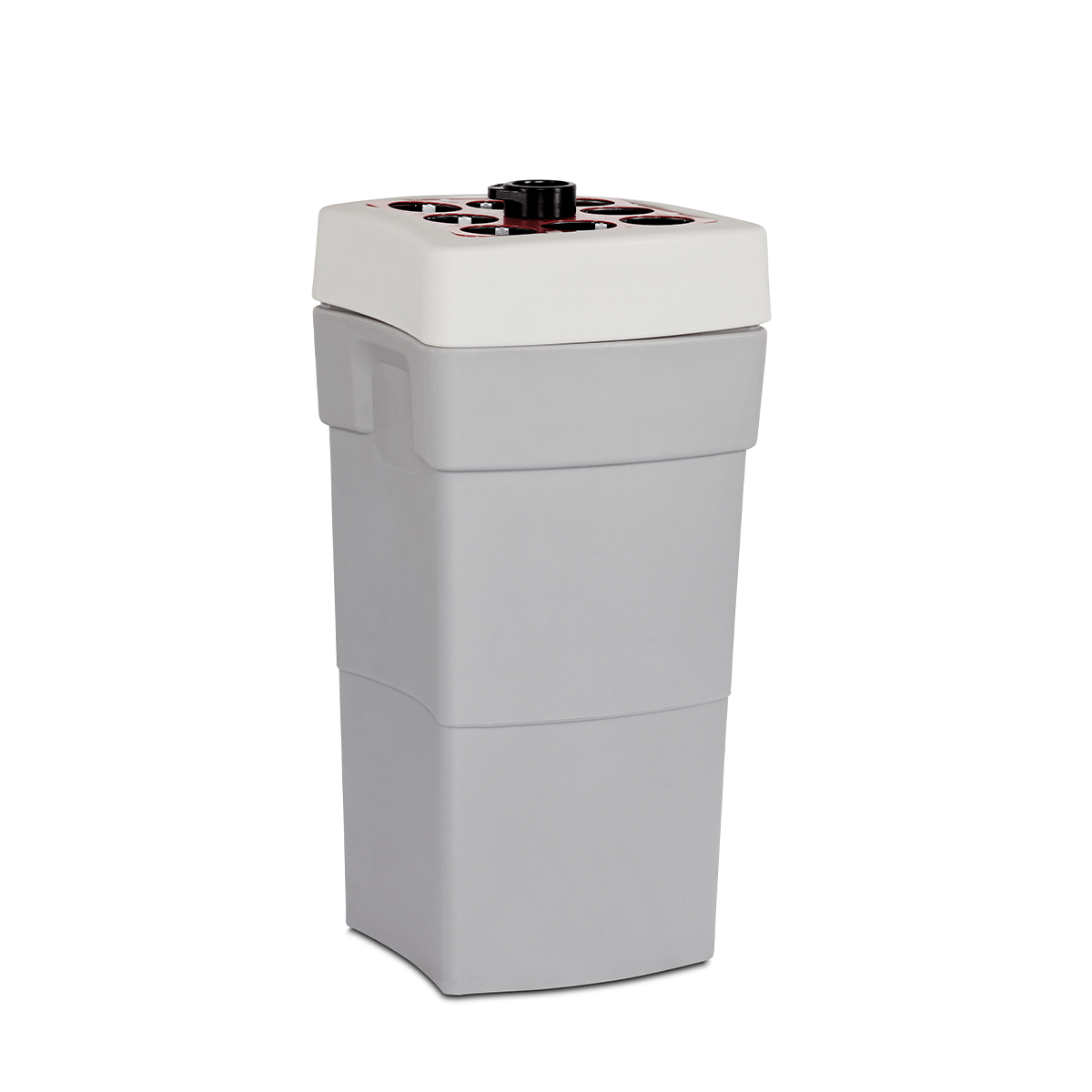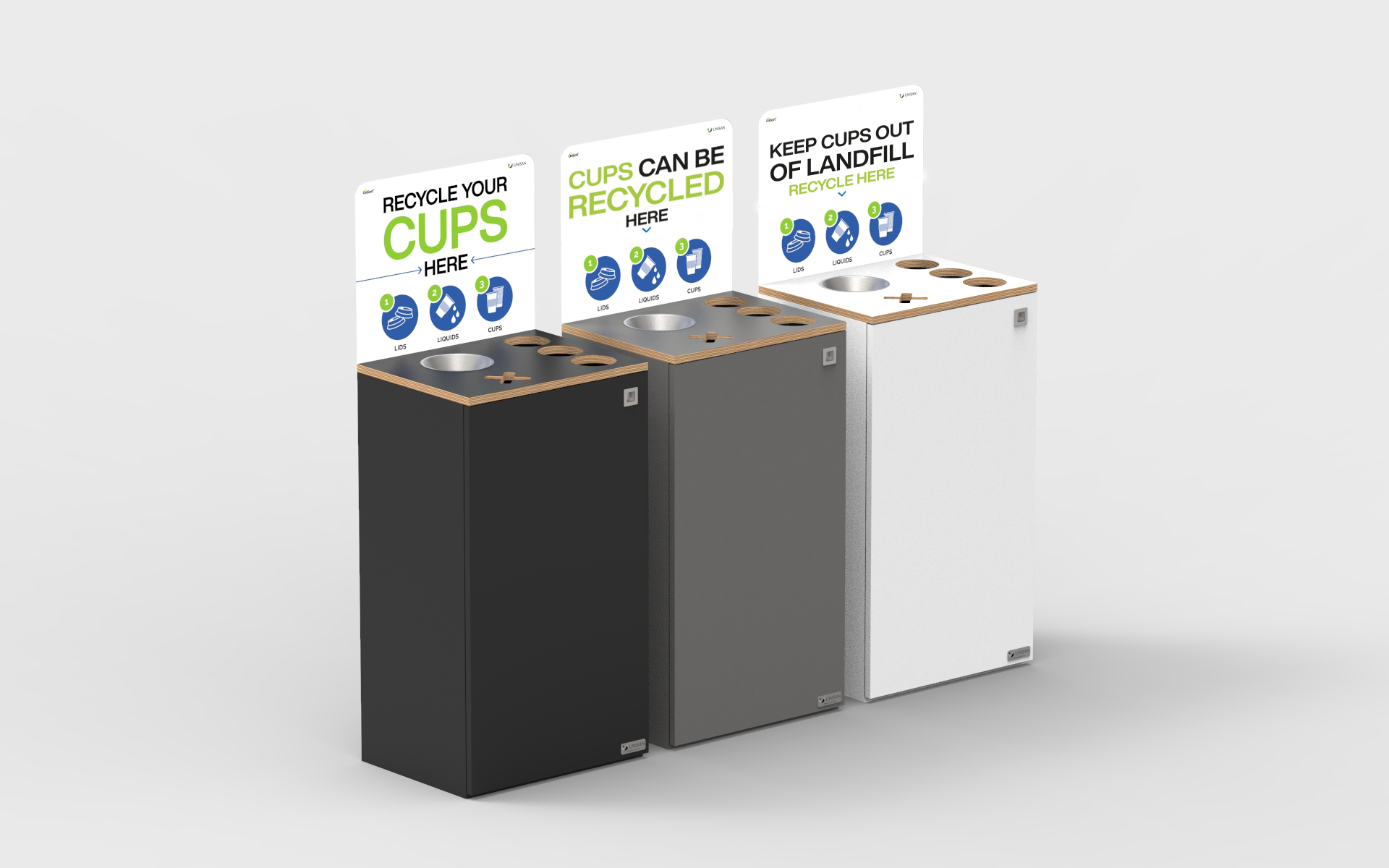Are coffee cups recyclable? What are the best way to ensure coffee cups are recycled? What is the best coffee cup recycling bin?
-
Contrary to popular belief, coffee cups can be recycled.
-
Disposable paper cups need to be collected in a designated coffee cup recycling bin.
-
Do not put coffee cups in paper recycling bins, or mixed recycling bins – it will render the whole waste lorry load of rubbish unrecyclable!
-
Having a coffee cup recycling in your workplace has massive benefits – it means you will send far less to landfill and improve your green credentials, but also will help you save money on waste collection.
Whether you like it or not, you can guarantee that disposable coffee cups will make their way into your offices and workplace. Though reusable cups are being encouraged more, convenience and hygiene means disposable coffee cups will never go away.
More and more businesses are adopting new processes and recycling programmes in the workplace to support their ‘zero waste to landfill’ missions. However disposable cups can often be forgotten, and unfortunately thrown into general waste. Introducing cup recycling into the workplace has many benefits, including cost savings on your landfill waste disposal.

DISPOSABLE COFFEE CUPS – FACTS
- In the UK we use 7 million disposable coffee cups every day, that’s 2.5 billion disposable coffee cups every year
- Less than 1 per cent of coffee cups are recycled
- Half a million cups are littered every day
- Packaging producers only pay for 10 per cent of the cost of packaging disposal and recycling.
- YouGov plc figures recently revealed that 52% of consumers dispose of their coffee cup at work and that 88% of the nation would use a purpose-built cup recycling bin if one was available to them.
First of all, let’s clear things up on what we mean by ‘disposable coffee cups’. There are several different kinds of disposable cups for hot drinks, made from paper, plastic and foam.
Paper cups, sometimes referred to as ‘paper hot cups’ are more commonly used for takeaway coffee and hot drinks today. They are sometimes used to serve cold drinks too.
Traditional Polystyrene cups: Made from petroleum, polystyrene foam cups are used for hot and cold drinks. Polystyrene makes the cup sturdy and lightweight while providing a high level of insulation. However, it is highly unusual for these to be recycled, and they should go in general waste. Very few recycling plants have
the technology to process single-use polystyrene foam cups (including used polystyrene foam food containers) and it is estimated that it takes hundreds of years to decompose in landfill and then it only breaks down into smaller particles. So these are definitely not an environmentally friendly cup option!
Plastic Cups: Cold drinks are often served in plastic cups at large public events and outdoor venues, and some takeaways. These cups are generally manufactured with polystyrene plastic, recyclable PET (polyethylene terephthalate) plastic or recyclable PP (polypropylene). Compostable cold cups made with PLA (polylactic acid) corn plastic are also available.
When it comes to paper cups… there are several different types.
Air Pocket Insulated Cups: Air is trapped for improved insulation between an inner and an outer ridged layer.
Poly-coated Paper Cups: Features a polymer coating for additional insulation, while protecting the outside of the cup from weakening.
Post-consumer Paper Cups: Made using a high percentage of recycled paper and therefore using less virgin material.
Sustainable Paper Cups: Compostable and biodegradable cups. The whole cup is produced with natural renewable resources.
Wax Coated Paper – Paper Cold Cups: For cold takeaway drinks, the wax coated paper cup offers extra rigidity and protection from leaks
Summary:
Whether you are using a paper cup for a hot or a cold drink, all paper cups feature a lining inside them to prevent liquid from leaking through the paper layers, while helping the cup retain its rigid form. This is where a polymer (plastic) or a wax lining may be used. Common linings include PE (polyethylene) plastic, PLA (polylactic acid) bioplastic and paraffin wax. It’s the cup lining and how they are bonded to the inside of the cup which really makes the difference when it comes to the ease with which takeaway cups can be recycled or disposed of in an environmentally friendly way.
The disposable coffee cups / paper cups that are most commonly seen across the UK in takeaway chains, are PE lined. They are recyclable, as long as they are collected in a separate container.
Are coffee cups recyclable?
YES! BUT….
Many people think coffee cups aren’t recyclable, but they actually are. However, they will not be recycled if you simply throw them in your mixed recycling bin, or paper recycling bin. Coffee cups need a designated bin/ waste stream, for just paper cups, in order for them to be successfully recycled and reprocessed into something new. Once recycled, paper from disposable cups can be reprocessed up to seven times and turned into new products including paper bags, greetings cards and notebooks, like this one from remarkable.co.uk.
The interior of disposable paper cups are usually lined with soft plastic or wax to prevent leaking, control extreme temperatures and increase its durability. This creates a weighty challenge when it comes to recycling, because the cup has to be stripped of its coating and broken down, which requires specialised infrastructure to do so. James Cropper PLC, a speciality paper mill group found that when separating fibre and plastic in disposable coffee cups, the fibre is actually extremely high quality, so they realised if they could separate the fibre and the plastic, there is an excellent raw material there that you can make high quality grades of paper from. So that’s what they did, and made an investment in a recycling plant in 2013 to be able to separate the fibre from the plastic in disposable cups.
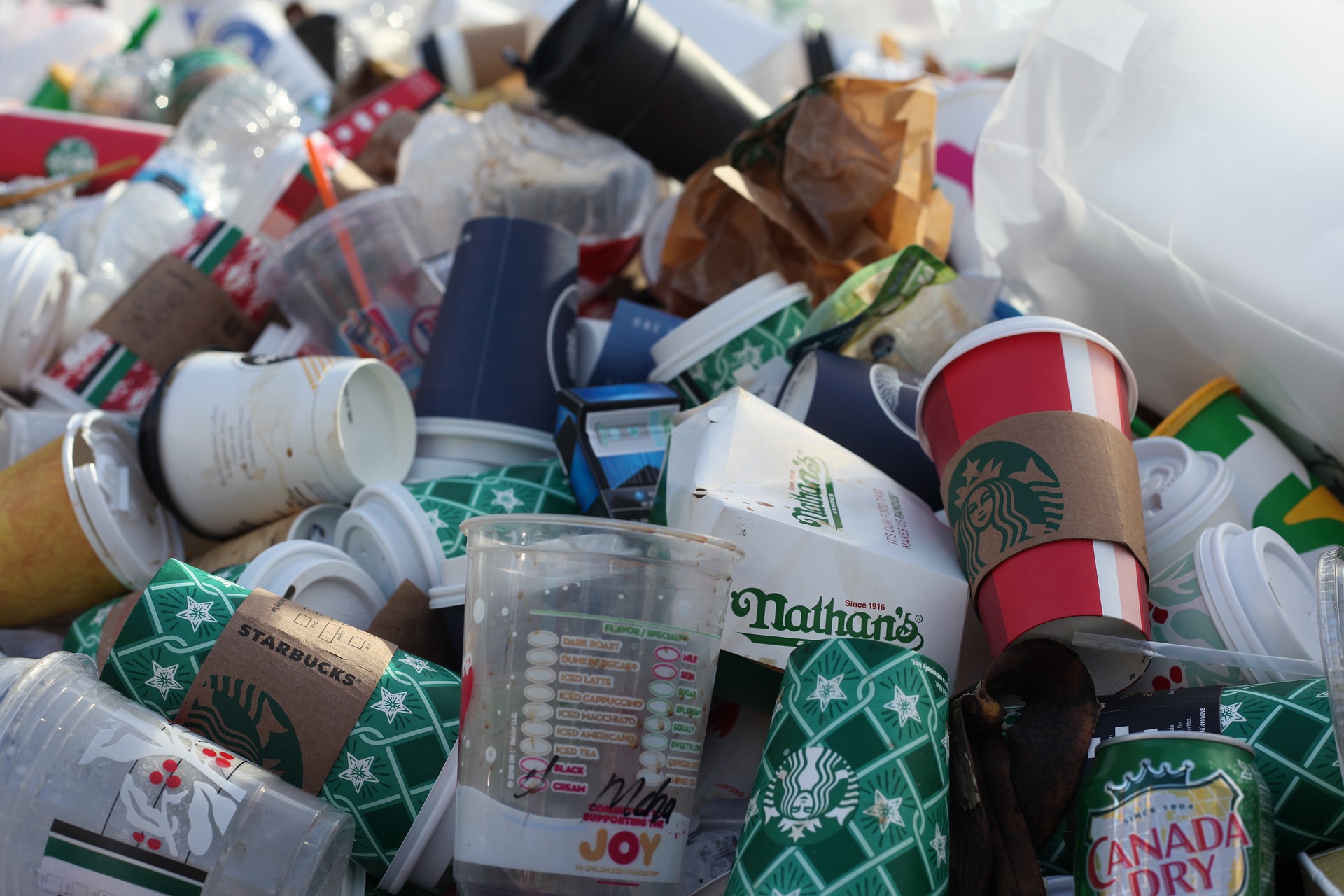 Another problem is the absence of dedicated bins for the collection of disposable cups… they are not a common site. This means that paper cups often end up on beaches, in parks, on the side of the road, in drains – everywhere but in a proper collection system! They also often end up being chucked in the nearest general waste bin or contaminating other recycling containers, which can contaminate the whole entire truck, and render the waste unrecyclable to the waste management company.
Another problem is the absence of dedicated bins for the collection of disposable cups… they are not a common site. This means that paper cups often end up on beaches, in parks, on the side of the road, in drains – everywhere but in a proper collection system! They also often end up being chucked in the nearest general waste bin or contaminating other recycling containers, which can contaminate the whole entire truck, and render the waste unrecyclable to the waste management company.
Not all recycling companies currently offer coffee cup reprocessing services, and is why they must be recycled separately in a designated bin, and collected separately from your other waste or recycling. In saying this, the coffee cup recycling infrastructure is quickly evolving across the UK. Waste management companies are introducing cup recycling services for coffee chains, retailers and businesses to prevent cups from needlessly going to landfill. A growing number of businesses are exploring the introduction of cup recycling programmes in the workplace too, or introducing a ‘reusable cup only’ policy.
The plants that currently have the capability to recycle the cups – DS Smith, James Cropper, Essity and ACE UK, recently stated that with an improved cup collection infrastructure, they alone could sustainably manage the recycling of all of the UK’s disposable paper cups.
Thankfully, making small changes means we can help this pressing environmental issue, there’s no need to give up coffee drinking – phew!
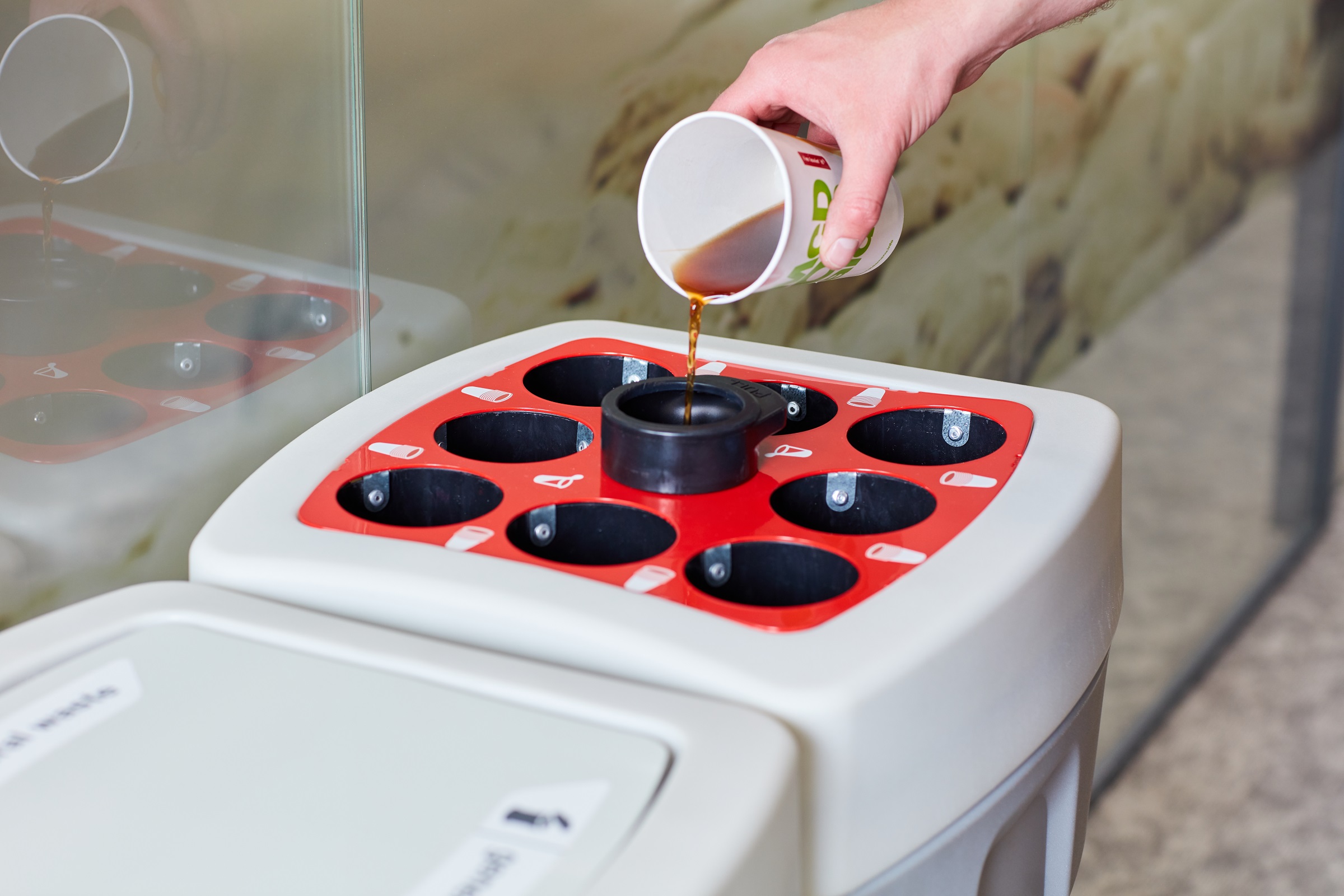
For disposable cup recycling to be actioned, used coffee cups must be collected systematically in bulk – this is where stream specific recycling bins come in to play. By placing a coffee cup recycling bin in areas where coffee is likely to be consumed – whether that’s in your office, in the canteen of your workplace, coffee shops, fast food restaurants, train stations, airports and so on – the likelihood of tossing used paper cups in any old bin is largely reduced. A dedicated recycling bin for disposable coffee cups will ensure that this waste does not contaminate other recyclable streams and it will also make bulk collection easier for you too.
Disposable paper cups cannot be disposed of in a general paper recycling bin at home, work or anywhere else. This is due to:
- The PE plastic lining inside the cup
- The waste liquid and residue in the cup which contaminates
the other paper - Once the cups are co-mingled with other recyclable and non-recyclable waste streams, they are difficult for processors to isolate and are often too damaged to recover.
Therefore, the most efficient method of disposal, to give the best chance of improving the recycling rates of the cups, is to empty out any cup waste (liquid and any other rubbish inside the cup) and gather the cups in a separate container away from other waste streams. This is also the case with used 100% compostable paper cups.
Managing the environmental impact of disposable coffee cups will take innovation and collaboration as well as improvements to local government policies, recycling infrastructure and general public awareness. Providing the opportunity to recycle the coffee cup in your organisation is definitely a great place to start.
Waste management operators, manufacturers, retailers and specialist recycling plants in the UK are now
working together and investing in the disposal, collection and reprocessing infrastructure needed to offer this facility for disposable coffee cups.
In 2018, Valpak and Costa launched The National Cup Recycling Scheme with an aim to increase the number of paper cups recycled. It is the UK’s first nationwide paper cup recycling scheme and Valpak is the Scheme administrator. The Scheme is free to join and makes paper cup recycling commercially attractive to waste collectors, due to a financial incentive of £70 per tonne of cups. This is on top of the commercial fee they receive for the material from the reprocessors.
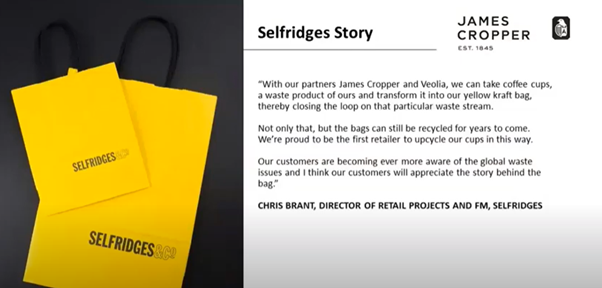
What are the benefits of introducing coffee cup recycling in my workplace?
Having a coffee cup collector bin and recycling scheme will ensure any coffee cups brought on your premises are recycled, which will reduce waste to landfill and improve your green credentials. Aside from the environmental benefit, recycling coffee cups can reduce your costs, as you will spend less on disposing general waste to landfill. Make changes today, that will benefit tomorrow!
We think cup recycling should really be made as easy and accessible as possible, and many people have said if a coffee cup recycling bin was available, they would use it. Providing a circular economy for disposable coffee cups will ensure that a large portion of the 2.5 billion coffee cups disposed every year can be processed into something new (that can be recycled again and again), instead of polluting the environment or going to landfill.
How to start coffee cup recycling?
Step 1. Evaluate your waste.
Establish the need for action and the type of action required towards implementing an efficient waste management programme.
If you work in an organisation where single-use cups are used or where colleagues or visitors bring them into the facilities, you may have already identified the potential for a disposable cup recycling programme.
If your workplace is large, conducting a waste audit can be helpful. This can assist you in quantifying the volume of disposable cups passing through the organisation, giving you an indication on what type of solution is required, for example;
• the capacity of the collection container and number of bins needed,
• where the cup collection points should be positioned in your building for maximum engagement;
• and the collection service requirements.
Don’t forget – if most of the disposable cups on your site are generated through in-house takeaway facilities, you will need to also review the type of cups being used. Is there room for improvement to switch to
a recyclable or biodegradable/ compostable alternative?
Step 2. Identify a cup collection service to use.
The next step is to talk to your existing waste contractor or
investigate whether any of the 12 waste management companies offer collection services for cup recycling or commercial composting in your area. This is a developing infrastructure and so even if you’re existing waste contractor does not offer a cup collection service right now, it is likely you will still have options, or they may do in the near future.
Speak to your chosen Waste management company, they will advise on how they will collect the cups from you. Some companies may provide biodegradable sacks or boxes for you to transfer the cups into ensuring that when they are emptied out of the cup bin they remain stored away from other waste streams to avoid any cross contamination.
According to recyclemore.co.uk this is details on the waste management companies who offer coffee cup collection services:
Veolia – all UK except Highlands
Grundon – London and Home Counties
Simply Cups – England
First Mile Collection – (London) / Post Back Scheme (UK)
Select Environmental Services – All RG postcodes, excluding RG28, All SL postcodes, excluding SL0, SL7,
SL8 and SL9, Guildford, Oxford
Paper Round BPR Group – London and Brighton
Bywaters Service – all of London and will service nationally on a case by case basis
Suez UK – See website for details
Biffa – Central London, Manchester
Helistrat – London, Worcester, Leicester, Derby, South Coast, Exeter, Bristol, Brighton, North East, Bolton, Manchester, Scotland, Scottish Boarders & West Scotland
Printed Cup Company – England
Cawleys – Hertfordshire, Bedfordshire, Buckinghamshire and Northamptonshire
Step 3. Find the right solution, that will work best for you
Unisan Cup collector recycling bin, Multibin Recycling Station with cups, liquids and lids section, Cup stacker bin with liquid compartment? To recycle single-use paper cups you must ensure they are emptied and disposed of into a separate container away from other waste, so choosing the right bin is crucial.
Veolia, a leading waste management company recommend solutions which can incorporate a ‘tip, flip and stack’ method of disposal, where any remaining liquid can be tipped away in a compartment in the bin, then the cup can be flipped over and stacked neatly upside down to aid further drying.
Think about where you will place the bins, and the capacity required. Is it going to be in a high footfall communal area, a corridor, an entrance hall, a break out area or canteen? Is it going to be back of house in the kitchen area?
See our range of coffee cup collection bins here, or contact us to discuss the best option for your company. We will tailor our solutions into what suits you best.
Step 4. Ensure optimum usage – positioning and signage is everything.
Identifying where your cup recycling containers should be located, for maximum visibility and accessibility to optimize the bins on-the-go usage is a very important step. Popular locations for frequent disposal include reception areas, communal eating and drinking areas, and main corridors.
With all recycling bins we sell, we stress that communication is key. The right signage can make all the difference, and luckily for you we can customise the signage or labelling on the bins to suit your requirements, and make them as eye-catching and engaging as possible. Think about how you will inform and educate employees, customers and visitors of your cup recycling programme and how they can correctly dispose of their cup, to make sure they are recycled.
Tell your team or customers about your new coffee cup recycling programme through communications such as email newsletters, your website, information boards, and posters around your facility.
Using communications like this is a great way of creating awareness, and emphasising the importance of recycling paper cups for the environmental and cost benefits.
Show your team a map of where your cup bins are stationed and make sure they know the key to improving the recycling rates of cups is that they are disposed of separately to other waste.
Clear signage around the bins also help boost awareness of your programme, whether to customers or staff.
Your recycling efforts are something to be proud of, don’t be afraid to shout about them through your social media accounts, blog posts on your organisation’s website or even through press releases to local media!
Step 5. Emptying the bins, arranging collection
How often you are required to empty the bins will obviously depend on the volume of cups you collect. It may take a short period of time to assess and adjust routines to the best times of emptying for your organisation. Unisan’s bins are state of the art, designed to be quick and easy to empty and reline.
If you’re a small business and you feel the volume of takeaway cups being disposed of in your workplace isn’t deemed viable for a recycling scheme, you can still take action to stop the cups going landfill and harming the environment. Consider joining forces with other businesses nearby for example, and collaborate on a cup recycling programme sharing collection points, emptying schedules and contractor costs.
What are the best coffee cup recycling bins?
Our Unisort Cup Collector is now ready and available for all your coffee cup recycling needs! With options to customise for your business or location, our multi waste stream cup collector has been cleverly designed to provide a clear guide to the user, for high engagement in recycling. Therefore, increasing recycling rates and reducing contamination of waste streams. Click here to read more about the Unisort Coffee Cup Collector recycling station, and get a quote.
The choices we all make are critical to reducing the sheer volume of disposable cups we send to landfill in this country. A recent YouGov Plc survery says that 84% of hot drink buyers are still using disposable paper cups.
Some manufacturers are re-designing disposable cups to improve the ease of recycling. Frugalpak are leading the way in the manufacturing of recyclable paper cups, which are specifically designing cups made from recycled cardboard and featuring an easy-to-separate liner. With separate cup disposal and collection methods available, these cups may also be recycled in general paper mills as well as the existing specialist recycling plants in the future.
UK bin suppliers such as Unisan now offer purposely designed coffee cup recycling bins and cup collector containers with individual compartments for liquid waste, plastic lids and collection tubes to collect the disposable cups separately, which are an excellent solution.
The Pronto recycling bin is available in many different waste streams, so you can create your own recycling station. A cup collector with a liquid compartment is one of the options, great for easy waste segregation to help increase recycling rates, and reduce contamination of other waste streams.
Our Multibin recycling stations can be customised to suit your exact needs. Whatever signage, colours and waste streams you need, we provide, to make recycling easy and more engaging for your staff and visitors. This is an example of a recent coffee cup collection point we recently created for a university, to go alongside an existing multibin. The bold, clear signage makes it obvious it is a coffee cup recycling bin, and makes it so much easier for people to make the right decision in a split second, and put their coffee cup in the correct waste stream, instead of in general waste. Click here to read more about the multibin coffee cup recycling station, and get a quote.
Here is another version of a multibin we designed and created for a major UK coffee chain. The perfect coffee cup recycling station has a waste chute for liquids, cups and lids. This ensures segregated collection of coffee cups so they can easily be recycled and gives people no excuse to litter their cup or throw it in a general waste bin.
Here’s an example of our ASPIRE coffee cup collector recycling station
To find out more on coffee cup recycling bins, and how you can introduce them into your workplace or store, contact us today for a chat. Our team of experts will be ready and willing to help.



